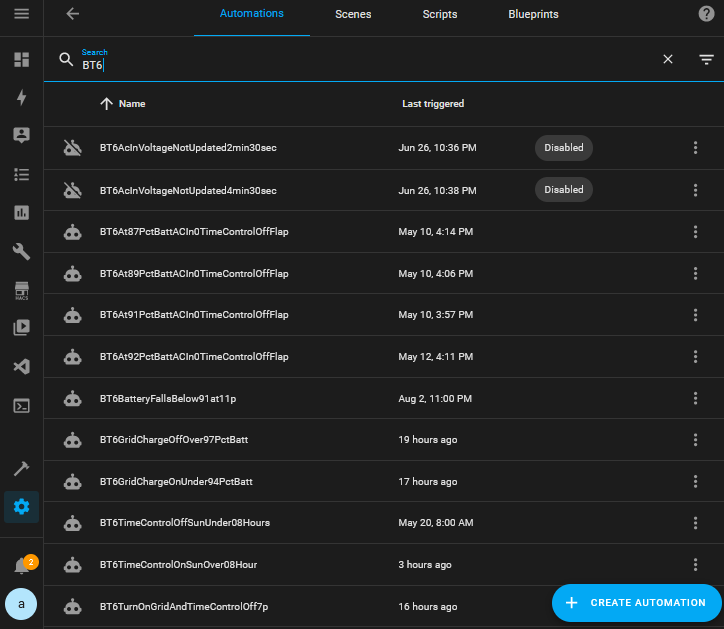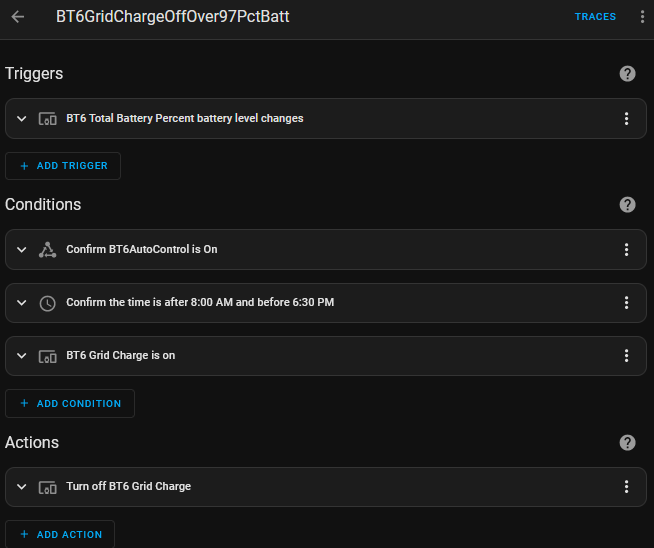Hey everyone,
im searching for a solution where i can use my EP500Pro as a buffer storage.
I have two 400W Solarpanel which are connected to Grid Inverter. Most of the produced energy goes into the public grid.
Im searching for a solution where i can charge my EP500 with the energy that doesnt get consumed by myself. When the sun its gone, the EP500 should provide the Grid Inverter with the needed energy over night.
Anyone of you build something similar?
For now i have a tasmota plug. Bluetti is set to 1A AC Charging and whenever i reached ~280W more than i need this plug turn on and charge. But this is really static setup
Thanks
Erik
Hi Erik,
Maybe I don’t understand your question correctly. Surely you can use all solar energy to charge the EP 500? If you know how many Watts of solar energy you want to use to charge the EP 500, you can set it accordingly, right? For example, up to 60% on grid and 30% on solar.
Thanks for your reply @JanNL_FR !
What I mean: Is there a possible way to reduce the export into the public grid and better save the energy into my EP500.
I have 2 Panels with 400wp each. They are connected to a grid inverter, so I can use the energy that the panels produce directly in my house. The downside of this is, when I don’t use every watt the panels produce, the energy just get into the public grid without any benefit for me.
And that energy that goes missing on that point should get the Bluetti instead
If you disconnect them from the grid inverter and charge the EP 500 from the panels you can use all the solar energy yourself as AC or DC power, day and night, or not?
Yes, sure. But then my house consume much more energy from the grid.
The best woould be something like:
Solar → Bluetti → Grid Inverter
Just an idea: So you need a signal from the EP500Pro, when it is 90% charged, which switches one of the 3 AC sockets and supplies power to your grid inverter, switches off again at 89% and EP500 can continue with solar charging.
I think this will work well with Home Assistant on RaspPi and a Shelly plug. It is a little programming. Depending how dir you are in programming it can be done.
I had something similar in mind with a Siemens LOGO! module. It has potential-free contacts that can be switched directly up to 8 Amps. I have no knowledge of Raspberry Pi and home automation, but I think it will indeed be possible and cheaper.
Well, i have a look at it. Thanks for you answer!
1 Like
I believe we need to understand how much energy you use throughout the day from your home, and how many KW/day you produce from panels to fully answer your question. Also is you grid inverter more efficient than the inverter in the EP500P?
I don’t export anything to the grid and my use case is different from yours, but I think a similar approach may work for you. My goal is to keep my EP500P charged between 94-97% for emergency power all the time (in case of grid failure), while making use of all solar power produced. I have two EP500P, and my solar production on each approximately matches my load usage on each phase during the day, so it may be slightly simpler compared to your usage.
I run in custom UPS mode, and turn on/off Time Control automatically at 8AM in HA based on weather report for “Hours of Sun” for today. Additionally, throughout the solar day, automation adjusts Grid Charge either on/off based on the Total Battery Percent. This means that EP500Ps’ supplies the power to loads entirely from battery/solar when set off and runs pass-through when set on. It results in my ability to use all of the solar energy produced for either usage or storage if I keep the battery from being charged up to 100%
It sounds like your loads are tied to Grid Inverter, but if you move some (or all) of those loads directly to EP500P you’ll have better control. It also sounds like you don’t want to export anything if you can back to grid. But in either case, it sounds reasonable that automating everything via HA is possible if you gradually remove Grid Inverter out of the equation. If you are producing much more energy than you consume, you could setup your system to run the EP500P from inverter nightly (or some portion of the night), then charge up EP500P via solar during the day while using EP500P inverter to power your loads. You would want to optimize your battery range start and end parameters automatically based on hours of sun for the following day, so that you minimize the need to charge batteries from the grid.
All of this is possible with bluetti-mqtt project in HA. It sounds like you should be able to do everything with software, and remove reliance on Tasmota and Grid inverter. Here’s some examples of automation I run while utilizing all solar power and keeping my EP500P charged for emergencies:
Hi @PowerMat
Thank you so much for your detailed answer. In my Opinion, it would be perfect just to charge my EP500 and consume everything from there. In reality its kinda bit more complicated.
The Grid inverter has a export limit of 600W. You arent allowed to go higher than that in germany. Everything thats running over the day like Fridge, Ventilation system, Network components etc. can run from this energy provided by the grid inverter.
Everything i what produce over 600W gets lost and everything from the possible 600W i didnt use in my house goes to the public grid. Both situations arent that great.
And as i said befoure, my compents like fridge etc. are really integrated and my EP500 is outside for Solarcharging. So i just cant connect every single device directly to the EP500.
I have the EU Version with SchuKo Plug. You just cant connect the normal SchuKo Plug into a free socket and it works magic.
Thanks for the clarification. Your answer leaves me still puzzled that I don’t understand your full setup. If Grid Inverter is only capable of output 600W and it should run your house and export at most 600W to grid (meaning you don’t use any power). It’s hard for me to believe the entire house runs less than 600W at a given time, is that right?
The EP500P is designed for attaching to house on a transfer switch from NEMA L14-30 plugs (from the manual it seems EU version has that too). Attaching this way will allow output up to 3000W. The configuration is pictured at the top here https://www.kickstarter.com/projects/bluetti/bluetti-ep500-and-ep500pro-the-new-era-of-home-backup-power/description
See the section labeled “【In-grid UPS Mode】” for more information on how that works. Ideally, you want to move Bluetti closer to where you have Grid Inverter and loads, then run longer DC solar wires inside. Another option (which is what I use) is to install a transfer switch or the “UPS Box (Sub Panel” pictured at that link. This allows you to distribute power directly to all your critical loads.
I’m curious how you use the EP500P in a power outage today, how do you hook up your loads? What do you currently have running from it (output)?
Hey again @PowerMat !
There are some more factors, which have influence my setup.
My house draw about 200W - 300W permanently. On really sunny days, the grid inverter produces 600W. So i have around 300W which going unused into the public grid.
The 600W border have to do which the cables and the fuses we use in Germany. We use 16A fuses here, 230V System. To prevent overheating of the cables the input Amps are restricted. This is because the cables are made for 16A but when you have a grid inverter which supply the house with energy, there are more Amps on the cable that actually draw from the grid. So in theory, you can draw ~18A on a 16A fuse. When you even more export and have something like a hotplate or similar on your cables might overload.
Thats why this 600W Border is set by the gouverment.
Sadly the EU Models dont have the NEMA Plug, its also dont support split phase etc.
For now its just a off grid System for me. Charge it via solar from my garage and plug thinks in when i need to do.
For now my EP500 is integradet via the SchuKo Plug directly to the Main Panel. In case of a power outage i can roll my EP500 in, plug it into the SchuKo Plug and switch the main switch from Grid to EP500.
The main problem with this is, EP500 just have one Phase through its inverter when i plug it into my main cuircuit. It does work because all remaining contacts get bridged. So its kinda virtual three Phase. This works for most of the products that dont need real three phase but there also systems like Hot plate or other really energy hungry things that cant be powered. So its really just for a emergency.
Have you thought about heating an electric boiler with your solar surplus?
1 Like
Nope, its just not enough solar energy to do this
There are water Heaters from 1500 Watt.
i just have about 400W overflow at peak
Ok, time for the next idea…? 

1 Like

